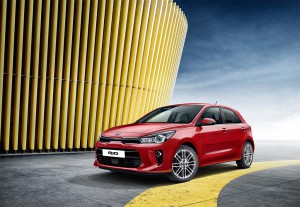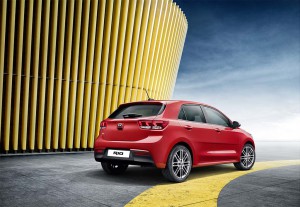
Kia's new Rio subcompact, which competes in Europe's toughest market, features a new exterior design.
Kia, which has used a combination of eye-catching design and new technology to win over customers, rolled out a updated version of its Rio subcompact passenger car during previews for the Paris Auto Show.
The new Kia Rio, one of the ambitious South Korean automaker’s key vehicles – it accounts for 16% of the company’s global sales – made its world debut in Paris at the 2016 Mondial de l’Automobile.
The fourth generation offers B-segment buyers, with new design both inside and out, a package of practicality and convenience, safety technology, new connectivity features and more engaging ride and handling in keeping with the automaker’s efforts to improve its suspensions and chassis in the wake of some intense criticism.
“The Rio is an important car for Kia, as our best-selling model worldwide,” according to Michael Cole, chief executive officer of Kia Europe. The B-segment is one of the most hotly contested areas of the new car market, and the third-generation Rio helped introduce more people to the Kia brand than ever before, Cole added.
“As a gateway to the brand, the Rio has typically offered an attractive design, low running costs and a practical nature. It’s for these reasons that the current model has sold in record numbers around the world. The new model will build on these key strengths, with higher desirability, a more enjoyable drive and the most advanced safety features in its class,” Cole said.
Cole added the B- or subcompact segment is the largest in the European new car market, and Kia anticipates that the new Rio will attract more than 100,000 buyers in its first full year on sale. This will place the Rio alongside Kia’s best-selling models in Europe, the Sportage and cee’d.
(Kia keys growth around new Cadenza. Click Here for the story.)
The new Rio, which was designed to appeal to a wide array of diverse customers, will play an increasingly important role in the Kia model line-up.
The Rio’s new exterior and interior design was led by Kia’s design centers in Germany and California, in close collaboration with the company’s domestic design base in Namyang, Korea. The appearance of the new Rio is defined by straight lines and smooth surfacing, giving the car a distinctive new look and more mature character than its predecessor, the company notes.
Up front, the Rio wears the latest evolution of Kia’s “tiger-nose” grille, now thinner in height and wider across the front of the car, with a gloss black grille cover. It is integrated with the newly designed bi-function headlamps, more sculpted for a sharper look, and featuring a new U-shaped LED daytime running light signature.
The Rio’s front fog lamp surrounds are moved outward and upward in the front bumper compared to their position on the third-generation model, adding greater visual width to the front of the car for a stronger overall look. The longer bonnet features bracket-shaped creases that run down from the base of the A-pillars to the grille and headlamps.
(Click Here for early driving impressions of the new Cadenza.)
In profile, the fourth-generation Rio’s lengthened, more balanced stance is achieved with a long bonnet and longer front overhang, Clearly-defined lines run down the full length of the car’s shoulder and along its doors, further stretching the appearance of the car for a more confident look.
The Rio introduced in Paris also features more sculptural forms and a more ergonomic layout than its predecessor. The interior has also been designed to accommodate the Rio’s new range of technologies such as connectivity features as well as optional driver assistance features, including automated emergency braking as well as Apple Car Play and Android Auto.
Like the exterior, straight lines running the width of the dashboard characterize the shape of the interior, giving the cabin a wider appearance and increasing the sense of space for occupants.
(Paris Motor Show brings big launches, but key makers absent. For more, Click Here.)
As well as long, lateral lines that govern the shape of the dashboard, horizontal vents further add to the visual width of the cabin, replacing the vertical vents of the third-generation model. Gloss black trim lines the central section of the dashboard.

